As we have explained, our business began some 43 years ago selling Sukhoi and then Yak aircraft. But firstly Sukhoi stopped production of sport aircraft in the early 2000’s, and no new Yak were being manufactured while the quality of the remaining used ones became very low. In some ways more important was the fact that under Putin, the export of any of these aircraft became a nightmare with paperwork often taking up to 2 years. At the same time we realised that with the 450 aircraft that we had sold, there are about 1300 Sukhoi, Yak and Chinese Nanchang in the West, and over a period of time all will require overhauled engines or indeed just engine parts. So we made the deliberate decision to move out of aircraft selling and into supplying engines and engine components.
Having said that we continue to sell the occasional aircraft, but typically Sukhois where we probably sold the aircraft originally, and indeed have sold a couple of them four times!
Sukhoi Su-26

Su-26
The Su-26 is still considered by many to be the world’s best aerobatic aircraft, although it is now over 25 years since the type first flew. In addition, many consider it to be a better competition aircraft than the later Sukhoi 31 for various reasons:
The standard Su-26 only has a 65 L fuselage tank and no wing tanks. In terms of cruising and range, this is obviously a disadvantage, unless the detachable belly tank is fitted. However, since almost all Su-31 were manufactured with integral wing tanks, a Su-26 without wing tanks is somewhat lighter than a Su 31 with wing tanks.
The Su-31 is somewhat more unstable and therefore more suitable for “freestyle” flying. Conversely the Su-26 is slightly more stable and therefore more suitable for precision “Aresti” type flying.
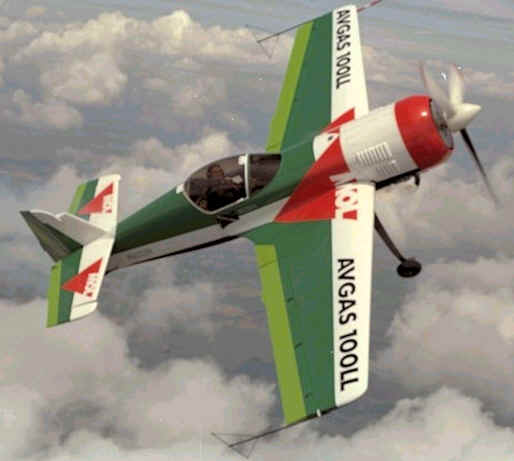
Su-26 in flight
Interestingly, the Russian Aerobatic Team obtained three modified Su-26 (called 26M3), which have dominated most recent World and European Championships. These have the longer Su-29 wing; the Zvesda pilot extraction system and the M9F 430 hp engine.
Since production of new Sukhoi aircraft has stopped some eight years ago, we can today only sell used aircraft that are known to us. However, we continue to modify existing Su-26 aircraft in a variety of ways such as:
- Fitting more powerful engines – typically the 425/430 hp PF engine with the new Barrett Pistons.
- Fitting the improved MTV-9-260-29 propeller
- Fitting lightweight electrical system, as well as other modifications such as a luggage box; better ventilation; Hooker harnesses et cetera
A new version, the Su-26MX was brought out which added 100 L tanks to each wing, dramatically increasing range without the inconvenience of a belly tank, albeit at a weight penalty.
A total of 69 Su-26M aircraft made and 11 MX.
Sukhoi Su-29
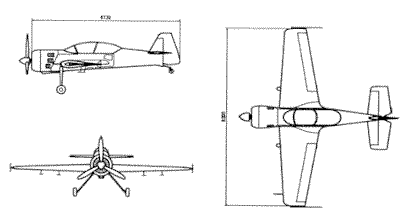
Su 29 Profile
The Sukhoi 29 is a two seater aircraft, which, when flown solo has the capability of doing well at a World Championship, yet also being suitable for aerobatic training and even touring – having a range of up to 1400 km.
By virtue of having a composite rear fuselage, the Su-29 only weighs some 35 kg more than the Su-26 and, in practical terms, the performance is almost identical, although the 29 is somewhat heavier on the controls.
The Su-29 is similar to other Sukhois with a high tensile stainless-steel forward fuselage, while the rear fuselage, tail and the entire wing structure is composite. It shares the single seaters extraordinary strength – the aircraft is cleared for +12/-10 G, and five wings were deliberately broken in tests, the minimum that one failed was at 23.5 G.
A total of 68 Su-29 were made
Sukhoi Su-31
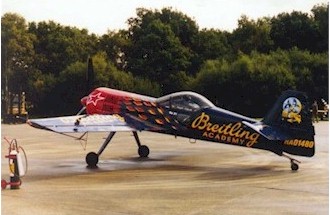
Su-31 Breitling Academy
The Sukhoi 31 is a development of the 26 with a composite rear fuselage, which reduces weight and increases strength. Other differences are:
The aircraft has a similar fuel system to the SU-26 in that it has a fuselage tank – in this case 70 L, which is the aerobatic tank. In addition it has additional long-range wing tanks of just over 100 L each which gives huge range, albeit with a certain weight penalty. A few Su-31 were made without wing tanks, and with long-range fuel being in detachable “Belly tanks”.
The Su-31 has three additional luggage areas, which make it quite exceptional for an aircraft of this sort:
-

Su-31
a bay behind the pilot
- a separate compartment in front of the pilot, above the fuselage tank.
- In a separate day in front of the instrument panel, where a specially designed “suitcase” can be quickly installed and then carried away from the aircraft.
In terms of flying qualities, the Su-31 is designed to be a little more unstable than the Su-26 although the difference is not great. This makes it more suitable for freestyle flying, but not quite as good for formal competition flying.
The canopy is side-opening which means that it can be opened with the engine idling – a great benefit in very hot weather while the aircraft is waiting for takeoff.
A total of 36 Su-31 were made.
Yak 12

Yak 12
The Y-12 Yak is a four seat utility and training aircraft, mostly fitted with the 260 hp AI-14 engine. The final and modified version is the-12 A with greater load-carrying capacity and a slower landing speed. The aircraft is very impressive for its short-field performance and its ability to lift large weights. Although produced in quite significant numbers the aircraft is rare today and a collector’s item.
Yak 18A

Yak 18A
The 18 A was the predecessor to the Yak-52 and built in large quantities. Sadly, under the Soviet system, once obsolete, virtually all the aircraft were destroyed. Many prefer the 18 A to the 52, since it is lighter; somewhat cleaner with a properly retracting undercarriage. The 18 A design was given to the Chinese who modified it into their CJ6 aircraft. The 18 A is a genuine collectors aircraft by virtue of its rarity and good flying characteristics.
Yak 18T
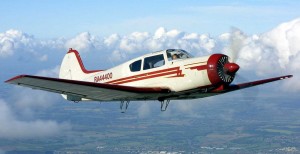
Yak 18T in flight
Background and history
We are undoubtedly the world leaders in these aircraft, having sold some 43 of them to owners around the world. We have also developed a wide range of modifications/improvements, which genuinely transform an already extremely versatile and capable aircraft.
The 18 T was designed as a multi-role light aircraft, but whose primary use was the training of Aeroflot pilots, but was also used for more generalised flight training and light transport in the Soviet Union.
Under the Soviet system of pilot training, all such aircraft need to be fully aerobatic, and the 18 T is capable of very impressive aerobatics, while remaining sufficiently stable to be an efficient instrument platform.

Yak 18T profile
All production of 18 T was at the Smolensk factory in Western Russia.
The first series of aircraft was from 1974 to 1982 when some 700 aircraft were produced. By some extraordinary Soviet logic, the Aeroflot training role was then allocated to the twin turbine Let 410, and many excellent 18 T were scrapped! However, the absurdity of this was realised and the type was reprieved, but about half the fleet had gone!
Slava Kondratiev, who had been one of the original designers then, with financial assistance from ourselves, put the aircraft back into production in 1992 and a second series of some 50 aircraft were then built.
Finally in 2009, the Russian Ministry of transport placed an order for 60 aircraft, again primarily in the training role, and these aircraft were produced. In passing, however they used almost all remaining engines, and indeed engine components, at the Voronezh Mechanical Plant.

Yak 18T instrument panel
Slava Kondratiev continued his development of the type, producing the SM 2000, a turbine derivative with the 750 hp Walter turbine, effectively only using the fuselage and undercarriages from the original aircraft. He also produced the SM 2000 P, effectively the same aircraft but with the M 14 P piston engine. Both were excellent aircraft, and quite significant improvements on the original, but Slava became bored with the projects; never went through with certification, and so only handfuls were made.
Qualities of the aircraft
Having been so closely involved with the 18 T for over 25 years, we are of course biased, but would point to:
The aircraft were genuinely built without regard to cost and to an extremely high technical standard.
They are extremely rugged in terms of rough-field performance, and capable of lifting and flying with loads dramatically in excess of the published maximum. Indeed Yakovlev conducted tests with an 18 T loaded to 500 kg (almost half a ton) over maximum gross weight, and it flew perfectly satisfactorily.
- Extremely roomy inside.
- Exceptionally good short field performance.
- Lovely to fly with very responsive controls – probably more than any other In aircraft.
The 18 T today
Unfortunately, no new aircraft are available, so the only 18 T we can offer are those that we have previously sold to existing customers.
Options and modifications
While we were selling new aircraft, we developed a range of modifications to enhance the aircraft performance and abilities. Of course these can be retro-fitted to existing aircraft, but at significantly greater cost than used to be the case with aircraft that were being manufactured or totally overhauled. These modifications include:
- More powerful engines, up to the current 430 hp engine which we now produce.
- Fitting MT 3-blade propellers, significantly enhancing the performance and quietness.
- Installing better sound deadening and improved door seals, both increasing the performance and reducing internal noise.
- Increasing fuel capacity, firstly with a 130 L tank in the rear fuselage, and then subsequently with additional 90 L tanks in each wing – both of these being on top of the existing 180 L capacity. Indeed, we produced a few aircraft combining both, giving huge endurance/range.
- We produced a variety of aircraft with different and improved instrumentation and avionics.
- The standard 18 T electrical system is beautiful quality but extremely heavy, so we replaced the 3 kW generator with a lightweight alternator; fitted lightweight batteries; by virtue of changing to much lighter Western flight instruments, a total weight saving of almost 100 kg was possible.
- Although very aerobatic, the standard aircraft does not have inverted oil/fuel, so we modified aircraft using the relevant systems from the Yak-52.
- We made many aircraft with an extremely luxurious interior, with high quality leather and carpets.
The current position of the 18 T in Europe
We were fortunate that EASA has given the 18 T restricted certification, which is valid throughout Europe, whichever country the aircraft is registered. In other countries outside Europe it operates on some form of restricted certification.
Yak-50

Yak 50
In our view, the 50 is one of the world’s most charismatic aircraft, and given the very small numbers left in the world (about 66) we are sure they will continue to appreciate in value. They provide the looks and flying qualities as well as performance of a Second World War fighter, together with relative economy of operation; lovely handling characteristics; a tough and extremely agile airframe – the type was twice World Aerobatic Champion.
Background and history
Yakovlev is probably the world’s most illustrious designer of aerobatic training and competition aircraft with a history going back to fantastic fighters – considered by many to be the best fighters of the Second World War.
 The first post-war aircraft was the 18, and this went through different variations and many thousands were made.
The first post-war aircraft was the 18, and this went through different variations and many thousands were made.
The first serious single-seater aircraft was the 18P, which in turn led to the PM and the PS, each model having lighter weight; more power and greater agility.
The 50 was the final iteration of these Yaks, designed by Sergei Yakovlev, the son of Yakovlev himself. Although a development of the 18 PS, the 50 was lighter with a monocoque fuselage and the then new 360 hp M 14 P engine.
The 50 was first flown in 1975, and then was put into quite large scale production at the Arsenyev factory in the Russian far East, with deliveries beginning later that year. The aircraft was an outstanding success, and immediately dominated the 1976 world Championships.
For such a specialised aircraft, the 50 was made in quite large numbers (312) until 1985. The vast majority went into DOSAAF in Russia, and the only ones exported were 8 to East Germany and 6 to Bulgaria.
With the introduction of the 55, Moscow instructed all Russian Aeroclubs to scrap 50s and return the logbooks to Moscow. Most obeyed this edict – hence so few aircraft are left in the world.
Qualities of the 50
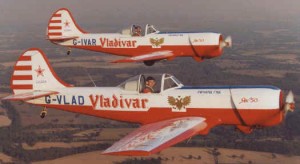
Pair of YAK-50’s
We imported the first 50s – indeed the first Russian aircraft – to the West in 1987, and operated a pair with sponsorship from Vladivar vodka. We genuinely feel that no other aircraft offers its combination of looks; performance and total charisma. The performance is spectacular, and with a 400 hp PF engine; three blade propeller and lightweight systems, a 50 will climb at over 5000 ft./m.
Structural issues
The 50 was designed to be flown very hard up to +9 and- 7G, but unfortunately it was introduced at a time that aerobatics were changing from big graceful manoeuvres, at which the 50 excelled, to much more brutal flying with high-G corners. The Russians were, of course, determined to win the various Championships at that time, and it is well-known that they flew the aircraft well in excess of these limits – certainly above 11 and possibly 12 G. This led to a succession of structural failures, each one was then corrected by further airframe strengthening. We have produced a paper on the modifications which we are happy to send.
Modifications
We introduced a wide variety of improvements to 50s when we were able to get older aircraft from Russia for total restoration. These included:
- More powerful engines – up to the 430 hp engines that we currently sell.
- Much greater performance through the use of the MT 3-blade propeller, which can be used with a 260 cm diameter on the 50.
- Long-range integral wing tanks, which more than double range/endurance
- Rounded wing-tips which looked rather more attractive and add a little to speed
- A lightweight electrical system with an alternator; light batteries and deleting the heavy Russian gyro.
Click here for a full list of Yak-50 Service Bulletins.
YAK-52

Yak 52
The 52 is a tricycle-gear, tandem two-seater military trainer. It offers a very high level of performance; a military-type character; fantastic ruggedness; high agility and very good aerobatic capabilities.
Background and history
Work began on the design in 1973, and the prototype began flying in 1974. Under a Comecon agreement, the Aerostar factory at Bacau in Romania was given licence for production, and some 1800 aircraft were made until the late 1990s. Since then small batches of aircraft have been made for Armed Forces, but production has now effectively stopped.
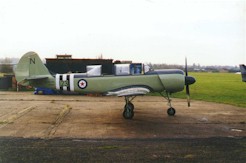
Yak 52
Qualities of the aircraft
- Fantastic value for money for an aircraft of this capability and which is built to military standards.
- Very charismatic feeling like a small “warbird”.
- Powerful with excellent performance.
- Tough and robust.
Conversely, for Western civilian use, it does have some disadvantages:
Limited range – but we can fit long-range wing tanks which more than double range.
- Limited space for additional avionics.
- Not much luggage space, but by leaving out some of the Russian avionics, a luggage locker behind the rear seat can be created.
- Aesthetics – in the sense that the undercarriages do not fully retract – of course a valuable safety feature if you fail to extend them before landing!

Yak 52 Profile
Service bulletins
The 52 has no less than 114 service bulletins, of which only 26 are important structural ones. Most of these ones can only be installed in a factory environment, and the most important of these are 59 and 60 (strengthened wing mountings), and 107 which is an external spar strap. It is advised that an aircraft without 59 and 60 should not do anything apart from very gentle aerobatics, and an aircraft which is going to be hard-flown should have all the service bulletins incorporated.
Lifetime
In their original use, the 52 was of course operated in a “military” environment and typically sat at one airfield doing nothing apart from hard aerobatics. In consequence the Russians gave the aircraft a renewable “lifetime” of 600 hours, after which it was returned to a factory; totally dismantled; everything checked and then rebuilt. In Western use it is recognise that this is not necessary, and according to the country in which it is flown, the different aviation authorities will have their own views and legislation about maintenance.
Within the UK, we came to an agreement between ourselves; Yakovlev in Moscow and UK CAA whereby this “total overhaul” at 600 hours was replaced by a very detailed inspection every 600 hours/15 years. In this the wings; tail; engine removed but only by a sufficient distance to insert measuring equipment, which then examines for any airframe problems.
Modifications and improvements
As with other Yak aircraft, we have devised a series of modifications to greatly improve the 52. These include:
- More powerful engines – up to 430 hp.
- Significantly more efficient MT propellers.
- Additional wing tanks to more than double fuel capacity.
- Lighter weight through deleting heavy Russian electrical systems, and replacing them with much lighter Western analogues
- Miniature Western avionics
- A rear mounted luggage box.
For further information on aerobatics and spin recovery – click here
Click here for Yak 52 service bulletins
Yak 55

Yak 55
As aerobatics changed from large graceful manoeuvres, which so suited the Yak 50, to much more violent corners, and very high rate of roll, Yakovlev asked Slava Kondratiev, probably Russia’s leading light aircraft designer, to produce a totally symmetrical mid-wing aircraft. The result was the 55. The airframe is immensely strong, and with almost full-span ailerons it has a very high rate of roll.
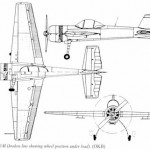
Yak 55 Profile
The prototype first flew in May 1981, but the Russian team were not equipped with 55s until 1984, when it immediately won the World Championship.
Yak 55M
Sukhoi brought out the Su-26 in 1985, and Yakovlev were spurred on to produce an aircraft with yet greater performance. The result was the 55M, which many feel was somewhat of a technological blind alley, since it reduced the wingspan quite considerably, and although this succeeded in producing a higher rate of roll, it was very much at the expense of increased induced drag. Therefore, in a competition sequence, although the “M” will roll past, it will actually lose more height than the “long-wing” 55.
Performance
We say that the 55 will give 85% of a Sukhoi’s performance at around 40% of the cost, which is a reflection of the aircraft capability. It is very tough, rugged and a good performance. It has quite a lot of drag because of its thick (but of course very strong) wing but does have a lot of power to overcome this.
The cockpit is roomy, although a little short in leg length for some Western pilots. Overall, it is a delight to fly, and is particularly easy in terms of its ground handling.
The 55 has been relatively free of service bulletins and has proved very effective in competition at all levels. Today, the 55 is outclassed at an international unlimited level, but is probably the best value for money in terms of advanced competition.
SP55M

SP55M

SP55M
The SP55M was a development, again by Slava Kondratiev with a number of improvements:
- Somewhat cleaner so faster
- Fully composite control surfaces so lighter and more responsive
- More ground clearance so able to use a 260cm prop
- Somewhat lighter weight

